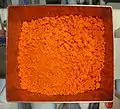< Wikijunior:How Things Are Made < Chemical
Products
 Rows of paint cans at a store
Rows of paint cans at a store
What materials do we need ?
Paint consists of pigments, solvents, resins, and various additives. The pigments is what gives the paint its colour; solvents make it easier to stick to the media (paper) applied ; resins help it dry faster; and additives serve many purposes such as fillers to anti-fungicidal agents.
What is the step by step process?
- Step 1: Pigment is premixed with resin (a wetting agent that assists in moistening the pigment),one or more solvents, and additives to form paste.
- Step 2: The paste mixtures are processed in a high-speed dispersion tank. There, the premixed paste is subjected to high-speed agitation by a circular, toothed blade attached to a rotating shaft. This process blends the pigment into the solvent.
- Step 3: The paste must now be thinned (using roll mill) to produce the paint.
- Step 4: The finished paint product is then pumped into the canning room and canned.
 Step1: Premixed base material for paint
Step1: Premixed base material for paint Step2: High speed dispersion mixer for paint
Step2: High speed dispersion mixer for paint Step3: The thinned paste after being rolled milled for thinning
Step3: The thinned paste after being rolled milled for thinning Step4: The paint mix are dispense into the can
Step4: The paint mix are dispense into the can
This article is issued from Wikibooks. The text is licensed under Creative Commons - Attribution - Sharealike. Additional terms may apply for the media files.